Sustainability Assessment of Finnegan Constructions: MBA402 Report
VerifiedAdded on 2022/08/14
|9
|2791
|13
Report
AI Summary
This sustainability assessment report analyzes Finnegan Constructions, a fictional construction company, based on the GRI Sustainability Reporting Standards. The report examines the company's performance across economic, environmental, and social dimensions. Economically, it addresses financial risks related to climate change, incidents of corruption, and anti-competitive behavior. Environmentally, it assesses energy consumption, impacts on biodiversity, and non-compliance with environmental regulations. Socially, the report investigates employee hiring and retention, workplace harassment, and community engagement. The assessment provides recommendations for improvements in each area, aiming to enhance the company's overall sustainability performance and align with ethical business practices. The report also references the case study provided in the assignment brief, detailing specific instances and providing analysis of the company's practices.
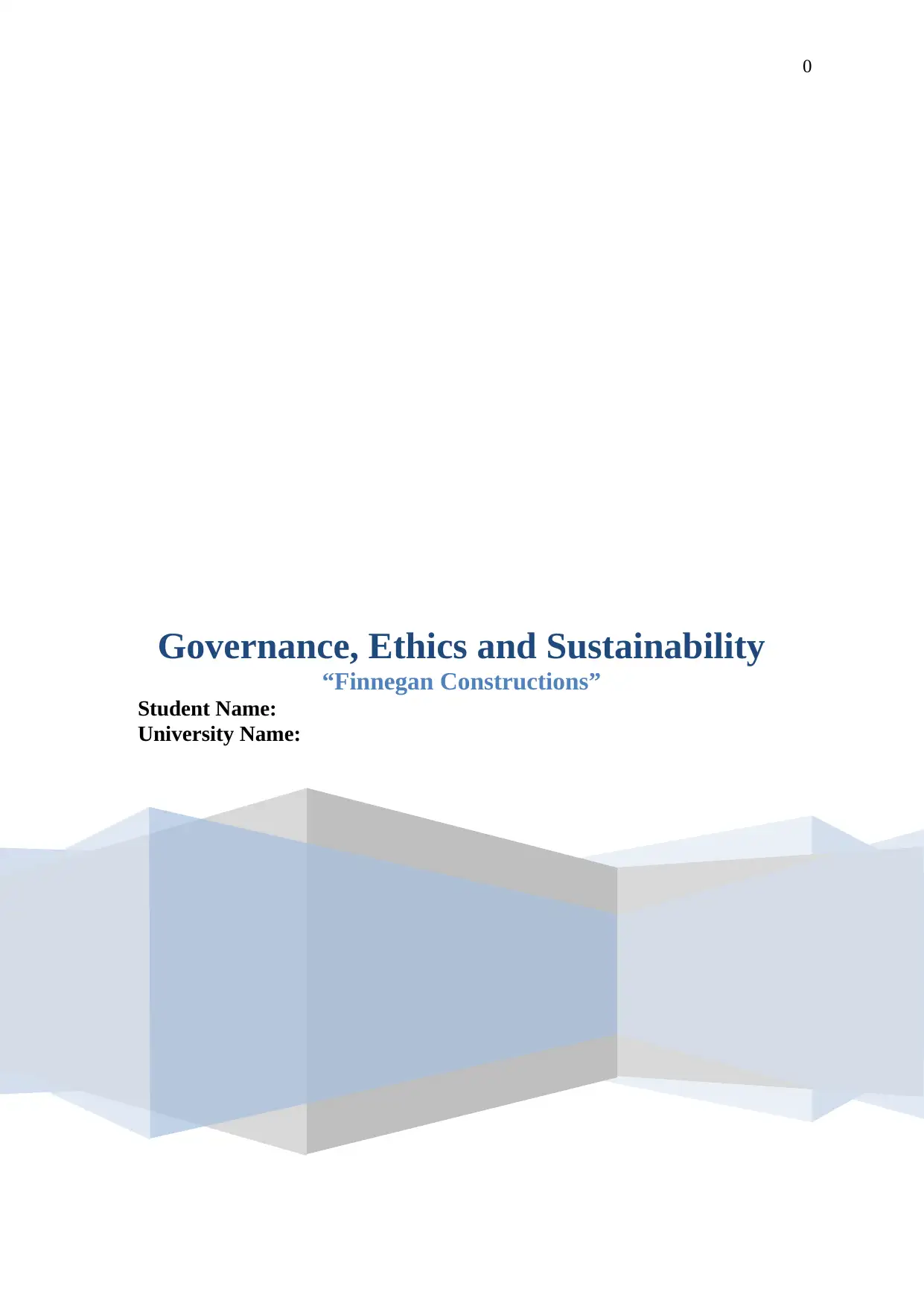
0
Governance, Ethics and Sustainability
“Finnegan Constructions”
Student Name:
University Name:
Governance, Ethics and Sustainability
“Finnegan Constructions”
Student Name:
University Name:
Paraphrase This Document
Need a fresh take? Get an instant paraphrase of this document with our AI Paraphraser

1
Introduction
Business sustainability is also termed as corporate sustainability that have some
environmental, economic and social demands that requires managing and coordinating for
ethical and responsible success consistently. The previous concept of sustainability includes
triple bottom line is considered by efforts evaluation in relation to profits affected in short-
term (Isil & Hernke 2017). It is important to focus on maintaining the factors of equality in
business sustainability between local impact and sustainable progress of the company for
ensuring about the affect positively on major stakeholders. Sustainability requires
maintaining the operations transparency in the business to ensure about the policies complied
effectively (Longoni & Cagliano 2018). The global guidelines are for the company dependent
on effective practices and actions under “Global Reporting Initiative (GRI)” to ensure the
effect on customers, stakeholders and shareholders engaged by the management. These
guidelines are applicable globally when to there is a sustainability reporting and featuring
inter-relatedness structure and report by showing practices at the universal level with impacts
of environmental, economic and social locally (Yadava & Sinha 2016). The case study of
“Finnegan Constructions” is analysed with GRI Reporting Standards execution to prepare the
company’s assessment report of sustainability with showing a local impact on shareholders,
customers, stakeholders, and others.
Economic Sustainability
In business, economic sustainability is essential for the human resources and long-
term material security within the economy. Sustainability is fulfilling an individual’s needs
by measuring optimal use, recovery and recycling for their better future (Rigamonti, Sterpi &
Grosso 2016). It requires earning returns and value investments by using natural resources
concerning long-term in the economy globally. In the economy, the supporting ability is
ensured in production and addressing problem by not wasting valuable resources in relation
to climate change and other aspects (Wu & Zhi 2016). In economic sustainability, the
company makes sure about taking actions against any individual’s engagement in corrupt
activities to avoid and save from not harming the stakeholders, customers and shareholders
interest.
Introduction
Business sustainability is also termed as corporate sustainability that have some
environmental, economic and social demands that requires managing and coordinating for
ethical and responsible success consistently. The previous concept of sustainability includes
triple bottom line is considered by efforts evaluation in relation to profits affected in short-
term (Isil & Hernke 2017). It is important to focus on maintaining the factors of equality in
business sustainability between local impact and sustainable progress of the company for
ensuring about the affect positively on major stakeholders. Sustainability requires
maintaining the operations transparency in the business to ensure about the policies complied
effectively (Longoni & Cagliano 2018). The global guidelines are for the company dependent
on effective practices and actions under “Global Reporting Initiative (GRI)” to ensure the
effect on customers, stakeholders and shareholders engaged by the management. These
guidelines are applicable globally when to there is a sustainability reporting and featuring
inter-relatedness structure and report by showing practices at the universal level with impacts
of environmental, economic and social locally (Yadava & Sinha 2016). The case study of
“Finnegan Constructions” is analysed with GRI Reporting Standards execution to prepare the
company’s assessment report of sustainability with showing a local impact on shareholders,
customers, stakeholders, and others.
Economic Sustainability
In business, economic sustainability is essential for the human resources and long-
term material security within the economy. Sustainability is fulfilling an individual’s needs
by measuring optimal use, recovery and recycling for their better future (Rigamonti, Sterpi &
Grosso 2016). It requires earning returns and value investments by using natural resources
concerning long-term in the economy globally. In the economy, the supporting ability is
ensured in production and addressing problem by not wasting valuable resources in relation
to climate change and other aspects (Wu & Zhi 2016). In economic sustainability, the
company makes sure about taking actions against any individual’s engagement in corrupt
activities to avoid and save from not harming the stakeholders, customers and shareholders
interest.
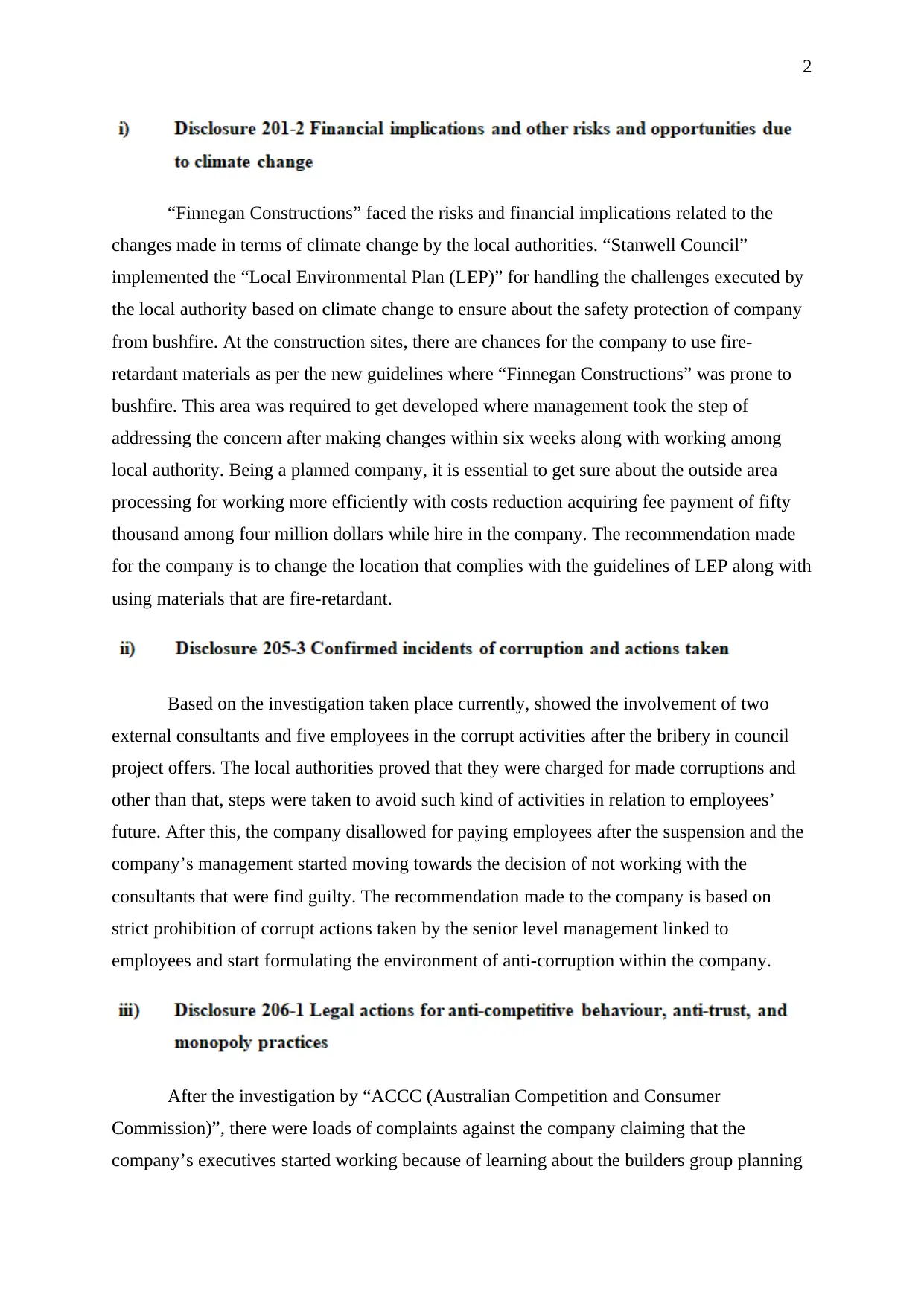
2
“Finnegan Constructions” faced the risks and financial implications related to the
changes made in terms of climate change by the local authorities. “Stanwell Council”
implemented the “Local Environmental Plan (LEP)” for handling the challenges executed by
the local authority based on climate change to ensure about the safety protection of company
from bushfire. At the construction sites, there are chances for the company to use fire-
retardant materials as per the new guidelines where “Finnegan Constructions” was prone to
bushfire. This area was required to get developed where management took the step of
addressing the concern after making changes within six weeks along with working among
local authority. Being a planned company, it is essential to get sure about the outside area
processing for working more efficiently with costs reduction acquiring fee payment of fifty
thousand among four million dollars while hire in the company. The recommendation made
for the company is to change the location that complies with the guidelines of LEP along with
using materials that are fire-retardant.
Based on the investigation taken place currently, showed the involvement of two
external consultants and five employees in the corrupt activities after the bribery in council
project offers. The local authorities proved that they were charged for made corruptions and
other than that, steps were taken to avoid such kind of activities in relation to employees’
future. After this, the company disallowed for paying employees after the suspension and the
company’s management started moving towards the decision of not working with the
consultants that were find guilty. The recommendation made to the company is based on
strict prohibition of corrupt actions taken by the senior level management linked to
employees and start formulating the environment of anti-corruption within the company.
After the investigation by “ACCC (Australian Competition and Consumer
Commission)”, there were loads of complaints against the company claiming that the
company’s executives started working because of learning about the builders group planning
“Finnegan Constructions” faced the risks and financial implications related to the
changes made in terms of climate change by the local authorities. “Stanwell Council”
implemented the “Local Environmental Plan (LEP)” for handling the challenges executed by
the local authority based on climate change to ensure about the safety protection of company
from bushfire. At the construction sites, there are chances for the company to use fire-
retardant materials as per the new guidelines where “Finnegan Constructions” was prone to
bushfire. This area was required to get developed where management took the step of
addressing the concern after making changes within six weeks along with working among
local authority. Being a planned company, it is essential to get sure about the outside area
processing for working more efficiently with costs reduction acquiring fee payment of fifty
thousand among four million dollars while hire in the company. The recommendation made
for the company is to change the location that complies with the guidelines of LEP along with
using materials that are fire-retardant.
Based on the investigation taken place currently, showed the involvement of two
external consultants and five employees in the corrupt activities after the bribery in council
project offers. The local authorities proved that they were charged for made corruptions and
other than that, steps were taken to avoid such kind of activities in relation to employees’
future. After this, the company disallowed for paying employees after the suspension and the
company’s management started moving towards the decision of not working with the
consultants that were find guilty. The recommendation made to the company is based on
strict prohibition of corrupt actions taken by the senior level management linked to
employees and start formulating the environment of anti-corruption within the company.
After the investigation by “ACCC (Australian Competition and Consumer
Commission)”, there were loads of complaints against the company claiming that the
company’s executives started working because of learning about the builders group planning
⊘ This is a preview!⊘
Do you want full access?
Subscribe today to unlock all pages.

Trusted by 1+ million students worldwide
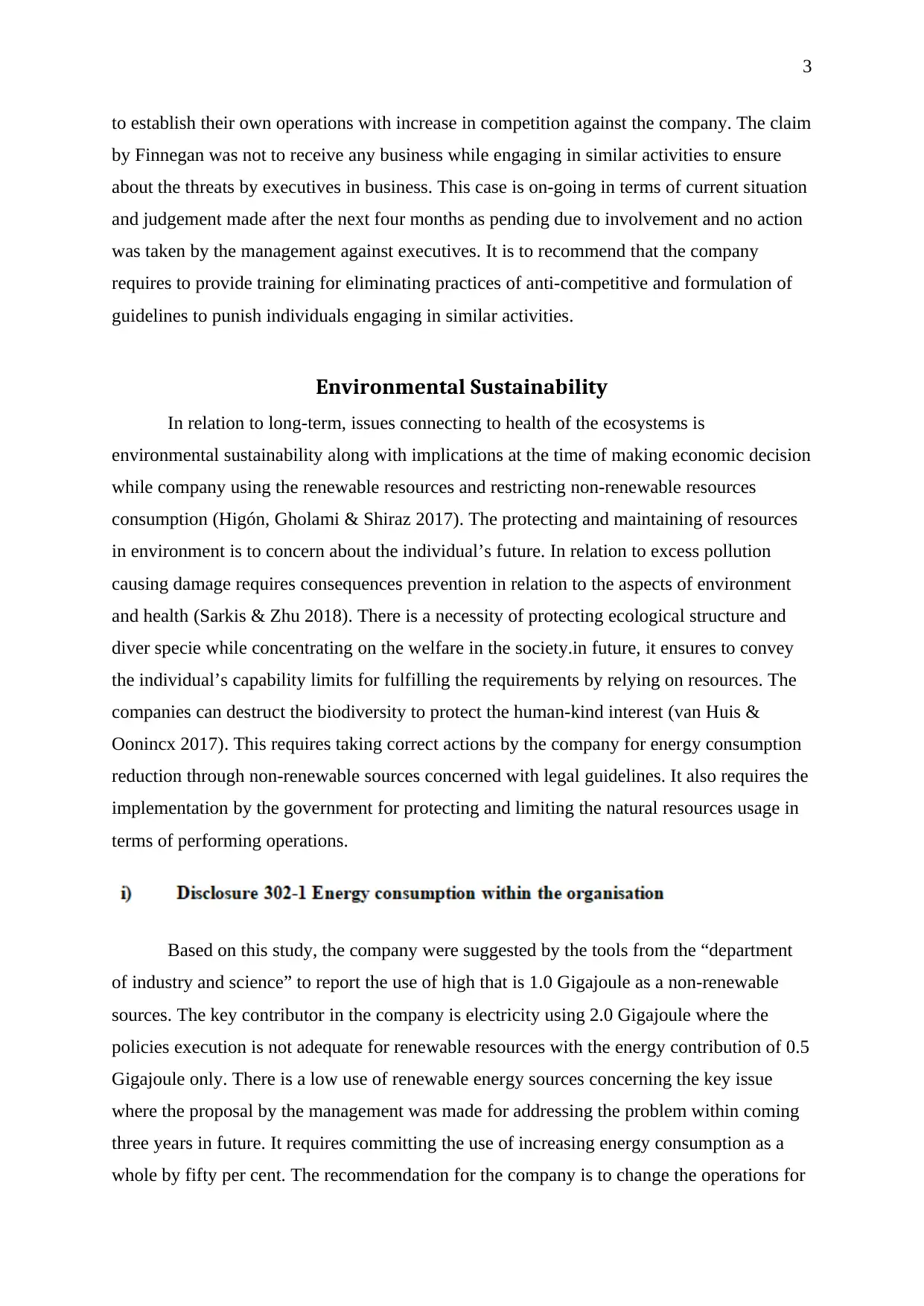
3
to establish their own operations with increase in competition against the company. The claim
by Finnegan was not to receive any business while engaging in similar activities to ensure
about the threats by executives in business. This case is on-going in terms of current situation
and judgement made after the next four months as pending due to involvement and no action
was taken by the management against executives. It is to recommend that the company
requires to provide training for eliminating practices of anti-competitive and formulation of
guidelines to punish individuals engaging in similar activities.
Environmental Sustainability
In relation to long-term, issues connecting to health of the ecosystems is
environmental sustainability along with implications at the time of making economic decision
while company using the renewable resources and restricting non-renewable resources
consumption (Higón, Gholami & Shiraz 2017). The protecting and maintaining of resources
in environment is to concern about the individual’s future. In relation to excess pollution
causing damage requires consequences prevention in relation to the aspects of environment
and health (Sarkis & Zhu 2018). There is a necessity of protecting ecological structure and
diver specie while concentrating on the welfare in the society.in future, it ensures to convey
the individual’s capability limits for fulfilling the requirements by relying on resources. The
companies can destruct the biodiversity to protect the human-kind interest (van Huis &
Oonincx 2017). This requires taking correct actions by the company for energy consumption
reduction through non-renewable sources concerned with legal guidelines. It also requires the
implementation by the government for protecting and limiting the natural resources usage in
terms of performing operations.
Based on this study, the company were suggested by the tools from the “department
of industry and science” to report the use of high that is 1.0 Gigajoule as a non-renewable
sources. The key contributor in the company is electricity using 2.0 Gigajoule where the
policies execution is not adequate for renewable resources with the energy contribution of 0.5
Gigajoule only. There is a low use of renewable energy sources concerning the key issue
where the proposal by the management was made for addressing the problem within coming
three years in future. It requires committing the use of increasing energy consumption as a
whole by fifty per cent. The recommendation for the company is to change the operations for
to establish their own operations with increase in competition against the company. The claim
by Finnegan was not to receive any business while engaging in similar activities to ensure
about the threats by executives in business. This case is on-going in terms of current situation
and judgement made after the next four months as pending due to involvement and no action
was taken by the management against executives. It is to recommend that the company
requires to provide training for eliminating practices of anti-competitive and formulation of
guidelines to punish individuals engaging in similar activities.
Environmental Sustainability
In relation to long-term, issues connecting to health of the ecosystems is
environmental sustainability along with implications at the time of making economic decision
while company using the renewable resources and restricting non-renewable resources
consumption (Higón, Gholami & Shiraz 2017). The protecting and maintaining of resources
in environment is to concern about the individual’s future. In relation to excess pollution
causing damage requires consequences prevention in relation to the aspects of environment
and health (Sarkis & Zhu 2018). There is a necessity of protecting ecological structure and
diver specie while concentrating on the welfare in the society.in future, it ensures to convey
the individual’s capability limits for fulfilling the requirements by relying on resources. The
companies can destruct the biodiversity to protect the human-kind interest (van Huis &
Oonincx 2017). This requires taking correct actions by the company for energy consumption
reduction through non-renewable sources concerned with legal guidelines. It also requires the
implementation by the government for protecting and limiting the natural resources usage in
terms of performing operations.
Based on this study, the company were suggested by the tools from the “department
of industry and science” to report the use of high that is 1.0 Gigajoule as a non-renewable
sources. The key contributor in the company is electricity using 2.0 Gigajoule where the
policies execution is not adequate for renewable resources with the energy contribution of 0.5
Gigajoule only. There is a low use of renewable energy sources concerning the key issue
where the proposal by the management was made for addressing the problem within coming
three years in future. It requires committing the use of increasing energy consumption as a
whole by fifty per cent. The recommendation for the company is to change the operations for
Paraphrase This Document
Need a fresh take? Get an instant paraphrase of this document with our AI Paraphraser
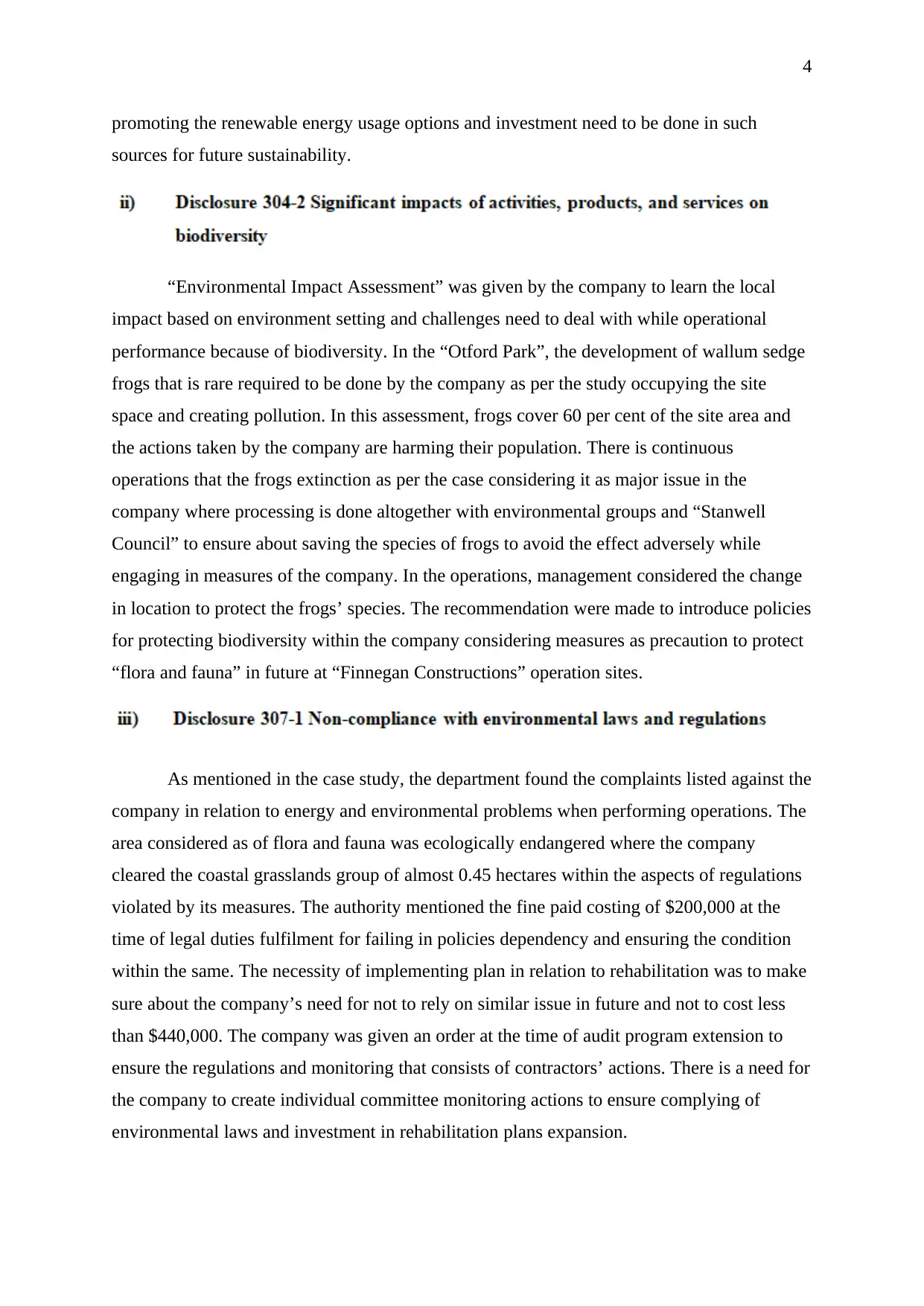
4
promoting the renewable energy usage options and investment need to be done in such
sources for future sustainability.
“Environmental Impact Assessment” was given by the company to learn the local
impact based on environment setting and challenges need to deal with while operational
performance because of biodiversity. In the “Otford Park”, the development of wallum sedge
frogs that is rare required to be done by the company as per the study occupying the site
space and creating pollution. In this assessment, frogs cover 60 per cent of the site area and
the actions taken by the company are harming their population. There is continuous
operations that the frogs extinction as per the case considering it as major issue in the
company where processing is done altogether with environmental groups and “Stanwell
Council” to ensure about saving the species of frogs to avoid the effect adversely while
engaging in measures of the company. In the operations, management considered the change
in location to protect the frogs’ species. The recommendation were made to introduce policies
for protecting biodiversity within the company considering measures as precaution to protect
“flora and fauna” in future at “Finnegan Constructions” operation sites.
As mentioned in the case study, the department found the complaints listed against the
company in relation to energy and environmental problems when performing operations. The
area considered as of flora and fauna was ecologically endangered where the company
cleared the coastal grasslands group of almost 0.45 hectares within the aspects of regulations
violated by its measures. The authority mentioned the fine paid costing of $200,000 at the
time of legal duties fulfilment for failing in policies dependency and ensuring the condition
within the same. The necessity of implementing plan in relation to rehabilitation was to make
sure about the company’s need for not to rely on similar issue in future and not to cost less
than $440,000. The company was given an order at the time of audit program extension to
ensure the regulations and monitoring that consists of contractors’ actions. There is a need for
the company to create individual committee monitoring actions to ensure complying of
environmental laws and investment in rehabilitation plans expansion.
promoting the renewable energy usage options and investment need to be done in such
sources for future sustainability.
“Environmental Impact Assessment” was given by the company to learn the local
impact based on environment setting and challenges need to deal with while operational
performance because of biodiversity. In the “Otford Park”, the development of wallum sedge
frogs that is rare required to be done by the company as per the study occupying the site
space and creating pollution. In this assessment, frogs cover 60 per cent of the site area and
the actions taken by the company are harming their population. There is continuous
operations that the frogs extinction as per the case considering it as major issue in the
company where processing is done altogether with environmental groups and “Stanwell
Council” to ensure about saving the species of frogs to avoid the effect adversely while
engaging in measures of the company. In the operations, management considered the change
in location to protect the frogs’ species. The recommendation were made to introduce policies
for protecting biodiversity within the company considering measures as precaution to protect
“flora and fauna” in future at “Finnegan Constructions” operation sites.
As mentioned in the case study, the department found the complaints listed against the
company in relation to energy and environmental problems when performing operations. The
area considered as of flora and fauna was ecologically endangered where the company
cleared the coastal grasslands group of almost 0.45 hectares within the aspects of regulations
violated by its measures. The authority mentioned the fine paid costing of $200,000 at the
time of legal duties fulfilment for failing in policies dependency and ensuring the condition
within the same. The necessity of implementing plan in relation to rehabilitation was to make
sure about the company’s need for not to rely on similar issue in future and not to cost less
than $440,000. The company was given an order at the time of audit program extension to
ensure the regulations and monitoring that consists of contractors’ actions. There is a need for
the company to create individual committee monitoring actions to ensure complying of
environmental laws and investment in rehabilitation plans expansion.
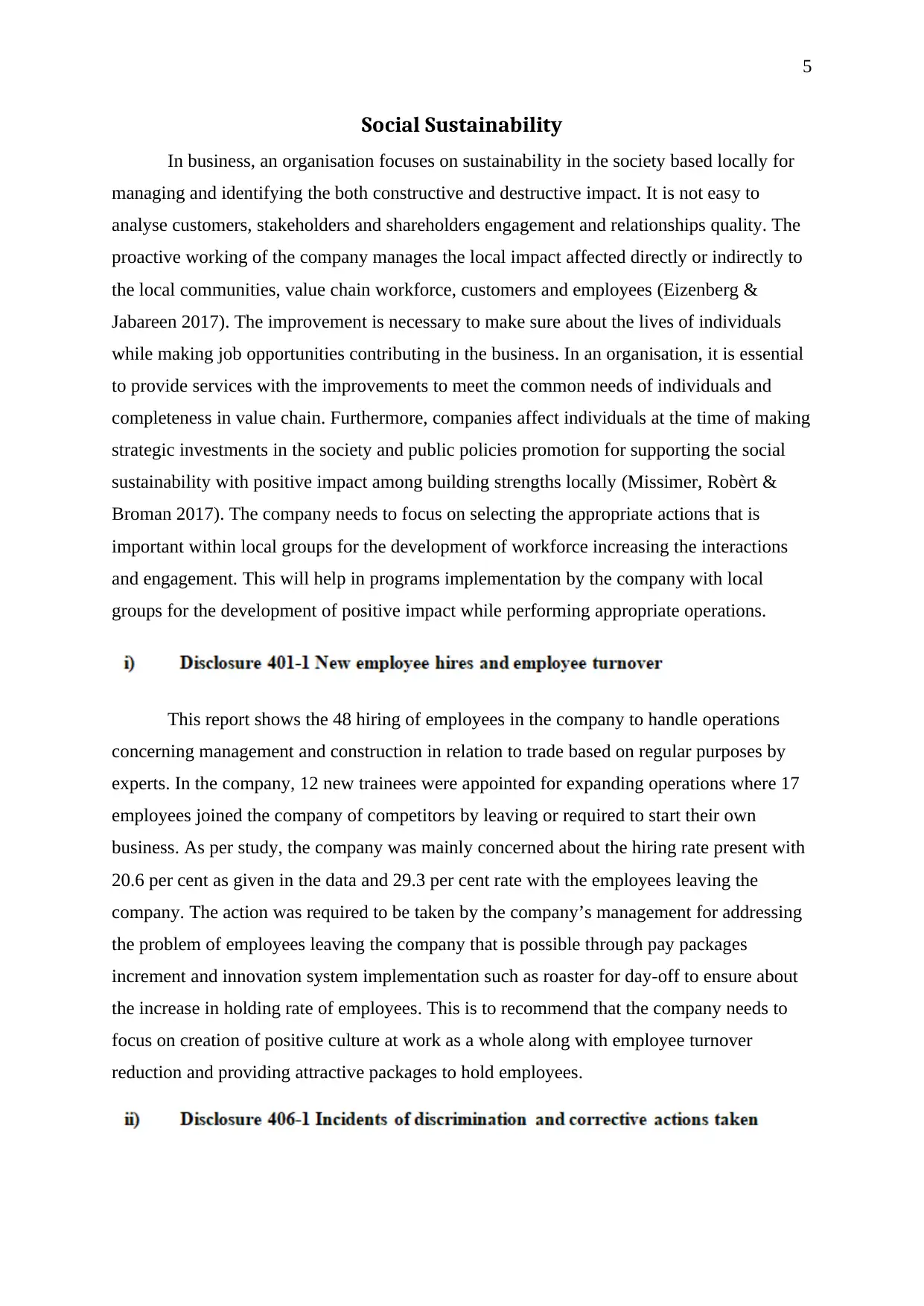
5
Social Sustainability
In business, an organisation focuses on sustainability in the society based locally for
managing and identifying the both constructive and destructive impact. It is not easy to
analyse customers, stakeholders and shareholders engagement and relationships quality. The
proactive working of the company manages the local impact affected directly or indirectly to
the local communities, value chain workforce, customers and employees (Eizenberg &
Jabareen 2017). The improvement is necessary to make sure about the lives of individuals
while making job opportunities contributing in the business. In an organisation, it is essential
to provide services with the improvements to meet the common needs of individuals and
completeness in value chain. Furthermore, companies affect individuals at the time of making
strategic investments in the society and public policies promotion for supporting the social
sustainability with positive impact among building strengths locally (Missimer, Robèrt &
Broman 2017). The company needs to focus on selecting the appropriate actions that is
important within local groups for the development of workforce increasing the interactions
and engagement. This will help in programs implementation by the company with local
groups for the development of positive impact while performing appropriate operations.
This report shows the 48 hiring of employees in the company to handle operations
concerning management and construction in relation to trade based on regular purposes by
experts. In the company, 12 new trainees were appointed for expanding operations where 17
employees joined the company of competitors by leaving or required to start their own
business. As per study, the company was mainly concerned about the hiring rate present with
20.6 per cent as given in the data and 29.3 per cent rate with the employees leaving the
company. The action was required to be taken by the company’s management for addressing
the problem of employees leaving the company that is possible through pay packages
increment and innovation system implementation such as roaster for day-off to ensure about
the increase in holding rate of employees. This is to recommend that the company needs to
focus on creation of positive culture at work as a whole along with employee turnover
reduction and providing attractive packages to hold employees.
Social Sustainability
In business, an organisation focuses on sustainability in the society based locally for
managing and identifying the both constructive and destructive impact. It is not easy to
analyse customers, stakeholders and shareholders engagement and relationships quality. The
proactive working of the company manages the local impact affected directly or indirectly to
the local communities, value chain workforce, customers and employees (Eizenberg &
Jabareen 2017). The improvement is necessary to make sure about the lives of individuals
while making job opportunities contributing in the business. In an organisation, it is essential
to provide services with the improvements to meet the common needs of individuals and
completeness in value chain. Furthermore, companies affect individuals at the time of making
strategic investments in the society and public policies promotion for supporting the social
sustainability with positive impact among building strengths locally (Missimer, Robèrt &
Broman 2017). The company needs to focus on selecting the appropriate actions that is
important within local groups for the development of workforce increasing the interactions
and engagement. This will help in programs implementation by the company with local
groups for the development of positive impact while performing appropriate operations.
This report shows the 48 hiring of employees in the company to handle operations
concerning management and construction in relation to trade based on regular purposes by
experts. In the company, 12 new trainees were appointed for expanding operations where 17
employees joined the company of competitors by leaving or required to start their own
business. As per study, the company was mainly concerned about the hiring rate present with
20.6 per cent as given in the data and 29.3 per cent rate with the employees leaving the
company. The action was required to be taken by the company’s management for addressing
the problem of employees leaving the company that is possible through pay packages
increment and innovation system implementation such as roaster for day-off to ensure about
the increase in holding rate of employees. This is to recommend that the company needs to
focus on creation of positive culture at work as a whole along with employee turnover
reduction and providing attractive packages to hold employees.
⊘ This is a preview!⊘
Do you want full access?
Subscribe today to unlock all pages.

Trusted by 1+ million students worldwide
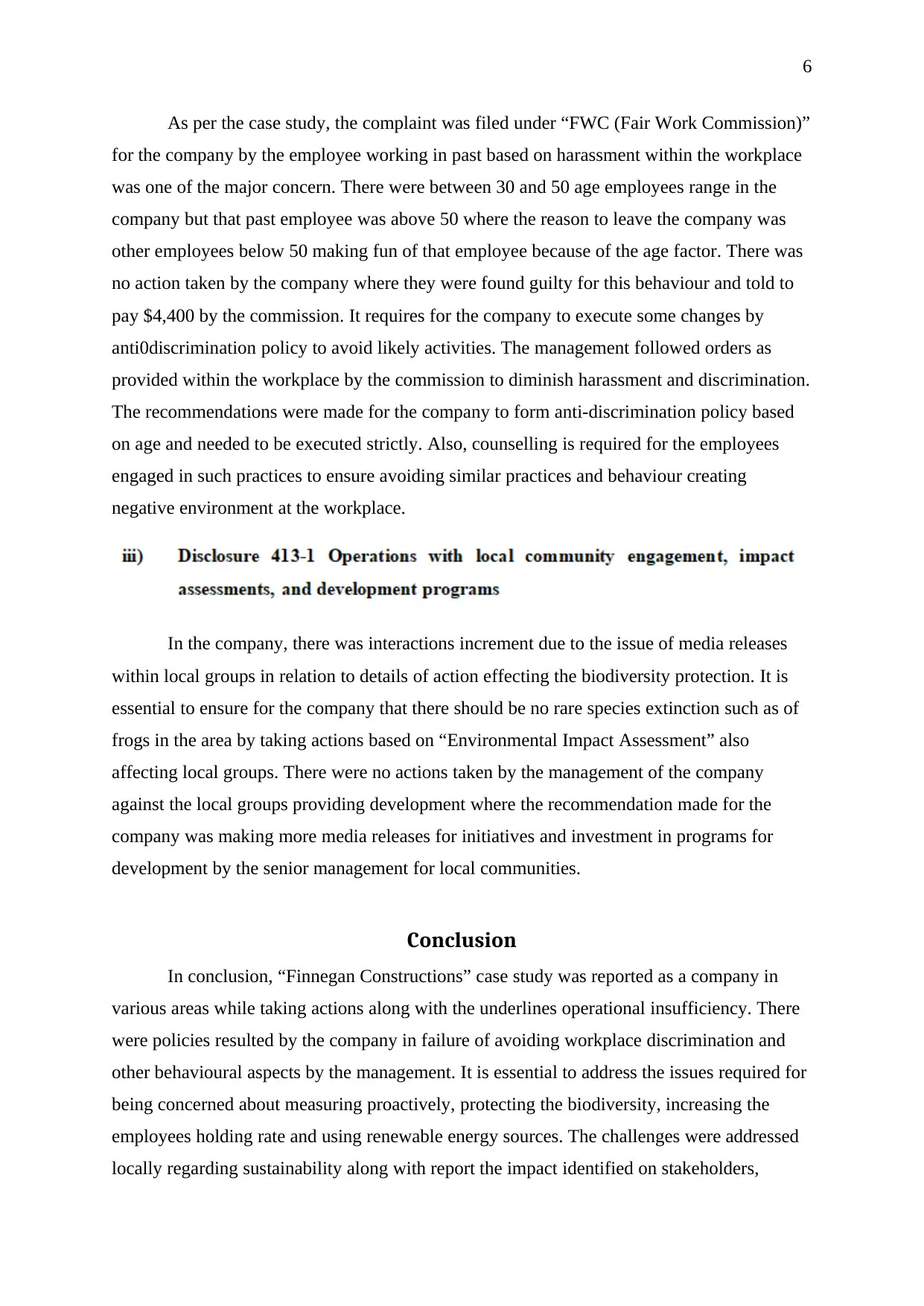
6
As per the case study, the complaint was filed under “FWC (Fair Work Commission)”
for the company by the employee working in past based on harassment within the workplace
was one of the major concern. There were between 30 and 50 age employees range in the
company but that past employee was above 50 where the reason to leave the company was
other employees below 50 making fun of that employee because of the age factor. There was
no action taken by the company where they were found guilty for this behaviour and told to
pay $4,400 by the commission. It requires for the company to execute some changes by
anti0discrimination policy to avoid likely activities. The management followed orders as
provided within the workplace by the commission to diminish harassment and discrimination.
The recommendations were made for the company to form anti-discrimination policy based
on age and needed to be executed strictly. Also, counselling is required for the employees
engaged in such practices to ensure avoiding similar practices and behaviour creating
negative environment at the workplace.
In the company, there was interactions increment due to the issue of media releases
within local groups in relation to details of action effecting the biodiversity protection. It is
essential to ensure for the company that there should be no rare species extinction such as of
frogs in the area by taking actions based on “Environmental Impact Assessment” also
affecting local groups. There were no actions taken by the management of the company
against the local groups providing development where the recommendation made for the
company was making more media releases for initiatives and investment in programs for
development by the senior management for local communities.
Conclusion
In conclusion, “Finnegan Constructions” case study was reported as a company in
various areas while taking actions along with the underlines operational insufficiency. There
were policies resulted by the company in failure of avoiding workplace discrimination and
other behavioural aspects by the management. It is essential to address the issues required for
being concerned about measuring proactively, protecting the biodiversity, increasing the
employees holding rate and using renewable energy sources. The challenges were addressed
locally regarding sustainability along with report the impact identified on stakeholders,
As per the case study, the complaint was filed under “FWC (Fair Work Commission)”
for the company by the employee working in past based on harassment within the workplace
was one of the major concern. There were between 30 and 50 age employees range in the
company but that past employee was above 50 where the reason to leave the company was
other employees below 50 making fun of that employee because of the age factor. There was
no action taken by the company where they were found guilty for this behaviour and told to
pay $4,400 by the commission. It requires for the company to execute some changes by
anti0discrimination policy to avoid likely activities. The management followed orders as
provided within the workplace by the commission to diminish harassment and discrimination.
The recommendations were made for the company to form anti-discrimination policy based
on age and needed to be executed strictly. Also, counselling is required for the employees
engaged in such practices to ensure avoiding similar practices and behaviour creating
negative environment at the workplace.
In the company, there was interactions increment due to the issue of media releases
within local groups in relation to details of action effecting the biodiversity protection. It is
essential to ensure for the company that there should be no rare species extinction such as of
frogs in the area by taking actions based on “Environmental Impact Assessment” also
affecting local groups. There were no actions taken by the management of the company
against the local groups providing development where the recommendation made for the
company was making more media releases for initiatives and investment in programs for
development by the senior management for local communities.
Conclusion
In conclusion, “Finnegan Constructions” case study was reported as a company in
various areas while taking actions along with the underlines operational insufficiency. There
were policies resulted by the company in failure of avoiding workplace discrimination and
other behavioural aspects by the management. It is essential to address the issues required for
being concerned about measuring proactively, protecting the biodiversity, increasing the
employees holding rate and using renewable energy sources. The challenges were addressed
locally regarding sustainability along with report the impact identified on stakeholders,
Paraphrase This Document
Need a fresh take? Get an instant paraphrase of this document with our AI Paraphraser

7
shareholders and customers. Lastly, the steps were taken for positive impact on the company
in future by the management improving carbon emissions reduction and employees
interaction.
shareholders and customers. Lastly, the steps were taken for positive impact on the company
in future by the management improving carbon emissions reduction and employees
interaction.
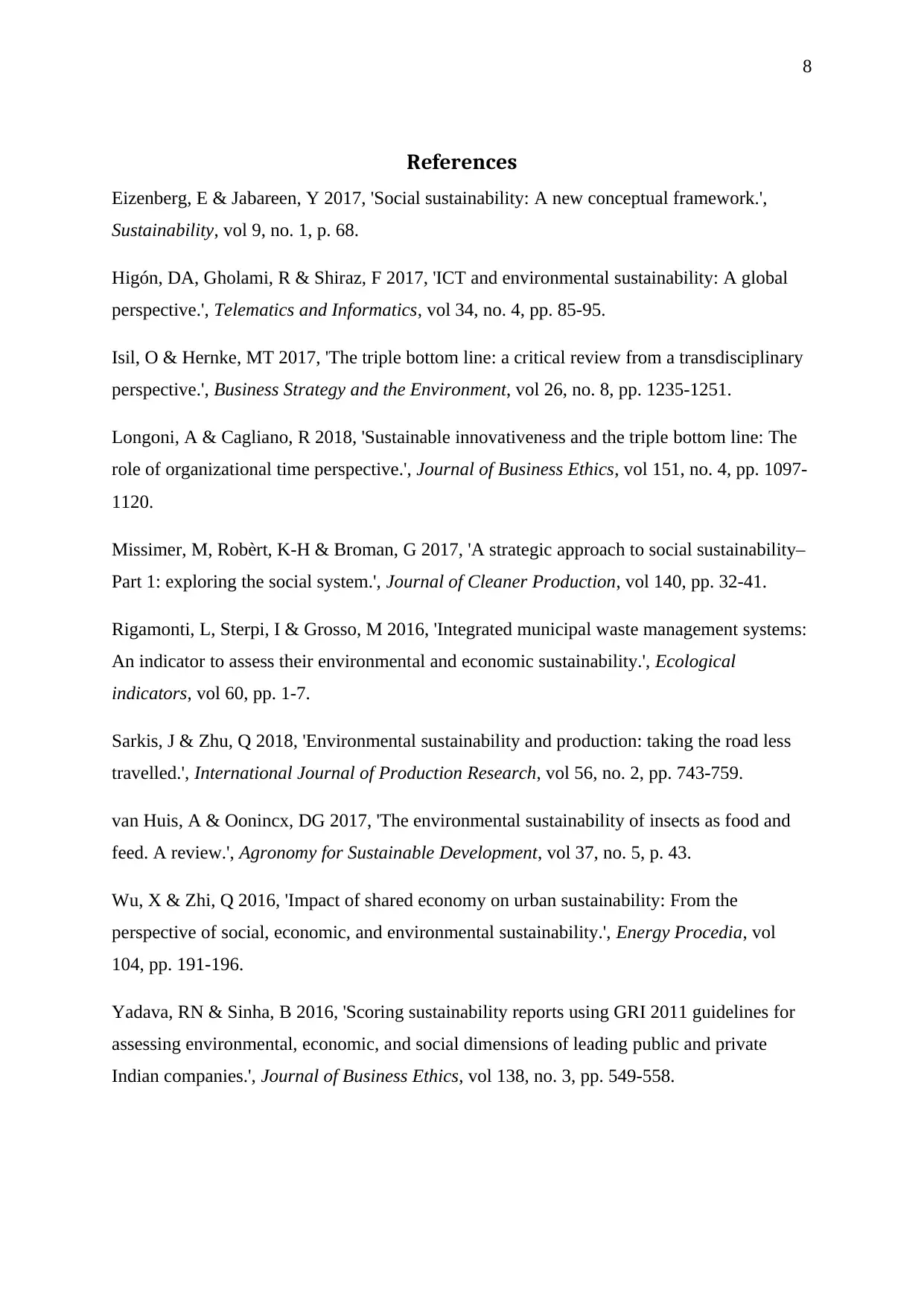
8
References
Eizenberg, E & Jabareen, Y 2017, 'Social sustainability: A new conceptual framework.',
Sustainability, vol 9, no. 1, p. 68.
Higón, DA, Gholami, R & Shiraz, F 2017, 'ICT and environmental sustainability: A global
perspective.', Telematics and Informatics, vol 34, no. 4, pp. 85-95.
Isil, O & Hernke, MT 2017, 'The triple bottom line: a critical review from a transdisciplinary
perspective.', Business Strategy and the Environment, vol 26, no. 8, pp. 1235-1251.
Longoni, A & Cagliano, R 2018, 'Sustainable innovativeness and the triple bottom line: The
role of organizational time perspective.', Journal of Business Ethics, vol 151, no. 4, pp. 1097-
1120.
Missimer, M, Robèrt, K-H & Broman, G 2017, 'A strategic approach to social sustainability–
Part 1: exploring the social system.', Journal of Cleaner Production, vol 140, pp. 32-41.
Rigamonti, L, Sterpi, I & Grosso, M 2016, 'Integrated municipal waste management systems:
An indicator to assess their environmental and economic sustainability.', Ecological
indicators, vol 60, pp. 1-7.
Sarkis, J & Zhu, Q 2018, 'Environmental sustainability and production: taking the road less
travelled.', International Journal of Production Research, vol 56, no. 2, pp. 743-759.
van Huis, A & Oonincx, DG 2017, 'The environmental sustainability of insects as food and
feed. A review.', Agronomy for Sustainable Development, vol 37, no. 5, p. 43.
Wu, X & Zhi, Q 2016, 'Impact of shared economy on urban sustainability: From the
perspective of social, economic, and environmental sustainability.', Energy Procedia, vol
104, pp. 191-196.
Yadava, RN & Sinha, B 2016, 'Scoring sustainability reports using GRI 2011 guidelines for
assessing environmental, economic, and social dimensions of leading public and private
Indian companies.', Journal of Business Ethics, vol 138, no. 3, pp. 549-558.
References
Eizenberg, E & Jabareen, Y 2017, 'Social sustainability: A new conceptual framework.',
Sustainability, vol 9, no. 1, p. 68.
Higón, DA, Gholami, R & Shiraz, F 2017, 'ICT and environmental sustainability: A global
perspective.', Telematics and Informatics, vol 34, no. 4, pp. 85-95.
Isil, O & Hernke, MT 2017, 'The triple bottom line: a critical review from a transdisciplinary
perspective.', Business Strategy and the Environment, vol 26, no. 8, pp. 1235-1251.
Longoni, A & Cagliano, R 2018, 'Sustainable innovativeness and the triple bottom line: The
role of organizational time perspective.', Journal of Business Ethics, vol 151, no. 4, pp. 1097-
1120.
Missimer, M, Robèrt, K-H & Broman, G 2017, 'A strategic approach to social sustainability–
Part 1: exploring the social system.', Journal of Cleaner Production, vol 140, pp. 32-41.
Rigamonti, L, Sterpi, I & Grosso, M 2016, 'Integrated municipal waste management systems:
An indicator to assess their environmental and economic sustainability.', Ecological
indicators, vol 60, pp. 1-7.
Sarkis, J & Zhu, Q 2018, 'Environmental sustainability and production: taking the road less
travelled.', International Journal of Production Research, vol 56, no. 2, pp. 743-759.
van Huis, A & Oonincx, DG 2017, 'The environmental sustainability of insects as food and
feed. A review.', Agronomy for Sustainable Development, vol 37, no. 5, p. 43.
Wu, X & Zhi, Q 2016, 'Impact of shared economy on urban sustainability: From the
perspective of social, economic, and environmental sustainability.', Energy Procedia, vol
104, pp. 191-196.
Yadava, RN & Sinha, B 2016, 'Scoring sustainability reports using GRI 2011 guidelines for
assessing environmental, economic, and social dimensions of leading public and private
Indian companies.', Journal of Business Ethics, vol 138, no. 3, pp. 549-558.
⊘ This is a preview!⊘
Do you want full access?
Subscribe today to unlock all pages.

Trusted by 1+ million students worldwide
1 out of 9
Related Documents
Your All-in-One AI-Powered Toolkit for Academic Success.
+13062052269
info@desklib.com
Available 24*7 on WhatsApp / Email
![[object Object]](/_next/static/media/star-bottom.7253800d.svg)
Unlock your academic potential
Copyright © 2020–2025 A2Z Services. All Rights Reserved. Developed and managed by ZUCOL.





